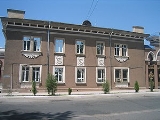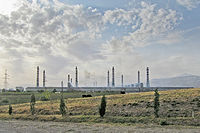
Tursunzade
Encyclopedia
Tursunzoda is a city in western Tajikistan
, known for its aluminium
smelting
plant TadAZ
. It is located 60 km west of Dushanbe
(40 km east of Hisor
), near the border with Uzbekistan
. It is near several rivers, Shirkent and Karatag immediately to the west and east of the city, and Kofarnihon
further east. Its population was given as 40,600 in the 1989 census, falling to 39,000 in 2000, and estimated at 37,000 in 2006.
The city has two television stations, TV-REGAR and TV-TADAZ, two newspapers, Aluminiy Tojikiston and Regar, and a radio station.
Tursunzoda is home to Stadium Metallurg
.
 Tursunzoda was originally the village of Regar, meaning "a town on sand". In 1978, the town and with it the whole district were renamed in honor of the Tajik national poet, Mirzo Tursunzoda
Tursunzoda was originally the village of Regar, meaning "a town on sand". In 1978, the town and with it the whole district were renamed in honor of the Tajik national poet, Mirzo Tursunzoda
. Its railroad station is still called Regar. The city developed from a village as a regional centre for an agricultural district in the western part of Gissar (Hisor) Valley
. Fruits, especially grapefruit
, vegetables, and cotton
are grown in the district. Thanks to plentiful irrigation from the local rivers, Tursunzoda district
is a major rice
-growing region, producing 1,400 tons, or 13% of Tajikistan's rice harvest in 2006. In the 1960s, the nearby Nurek Dam
hydroelectric power station on the Vakhsh River
made the city a good location for industry, and besides the aluminium plant, there are also china, brick, cable, and cotton cleaning plants.
 The Tajik aluminium smelting plant, TadAZ
The Tajik aluminium smelting plant, TadAZ
, in Tursunzoda, is the largest aluminium manufacturing plant in Central Asia
, and possibly the world, and Tajikistan's chief industrial asset. The country has no native aluminium ore, so the raw material for the plant has to be imported. Construction of the plant proper began in 1972, and the first pouring of aluminium took place on March 31, 1975. It consumes 40% of the country's electrical power, and a 2002 study found it responsible for notable fluorine
water pollution in the region.
Tajikistan
Tajikistan , officially the Republic of Tajikistan , is a mountainous landlocked country in Central Asia. Afghanistan borders it to the south, Uzbekistan to the west, Kyrgyzstan to the north, and China to the east....
, known for its aluminium
Aluminium
Aluminium or aluminum is a silvery white member of the boron group of chemical elements. It has the symbol Al, and its atomic number is 13. It is not soluble in water under normal circumstances....
smelting
Smelting
Smelting is a form of extractive metallurgy; its main use is to produce a metal from its ore. This includes iron extraction from iron ore, and copper extraction and other base metals from their ores...
plant TadAZ
TadAZ
The Tajik Aluminium Company , abbreviated as TALCO headquartered in Tursunzoda, Tajikistan, runs the largest aluminum manufacturing plant in Central Asia, and is Tajikistan's chief industrial asset....
. It is located 60 km west of Dushanbe
Dushanbe
-Economy:Coal, lead, and arsenic are mined nearby in the cities of Nurek and Kulob allowing for the industrialization of Dushanbe. The Nurek Dam, the world's highest as of 2008, generates 95% of Tajikistan's electricity, and another dam, the Roghun Dam, is planned on the Vakhsh River...
(40 km east of Hisor
Hisor
Hisor is a city in western Tajikistan, about 15 km west of Dushanbe. It is the capital of Hisor District, one of the Districts of Republican Subordination. It lies at an altitude of 799-824 m, surrounded by high mountains . The Khanaka River, a tributary to the Kofarnihon River, flows through the...
), near the border with Uzbekistan
Uzbekistan
Uzbekistan , officially the Republic of Uzbekistan is a doubly landlocked country in Central Asia and one of the six independent Turkic states. It shares borders with Kazakhstan to the west and to the north, Kyrgyzstan and Tajikistan to the east, and Afghanistan and Turkmenistan to the south....
. It is near several rivers, Shirkent and Karatag immediately to the west and east of the city, and Kofarnihon
Kofarnihon River
Kofarnihon River or Kofirnihan is one of the major tributaries of Amudarya...
further east. Its population was given as 40,600 in the 1989 census, falling to 39,000 in 2000, and estimated at 37,000 in 2006.
The city has two television stations, TV-REGAR and TV-TADAZ, two newspapers, Aluminiy Tojikiston and Regar, and a radio station.
Tursunzoda is home to Stadium Metallurg
Stadium Metallurg 1st District
Stadium Metallurg is a multi-use stadium in Tursunzoda, Tajikistan. It is currently used mostly for football matches and serves as the home of Regar-TadAZ Tursunzoda of the Tajik League. The stadium has a capacity of 20,000 people....
.
History

Mirzo Tursunzoda
Mirzo Tursunzoda - was an important poet and a prominent politic figure. Today Tursunzoda has been elevated to the level of a national hero of Tajikistan. Tursunzoda's face appears on the front of the one Somoni note. The town of Tursunzoda is named in his honor. He was awarded the Stalin...
. Its railroad station is still called Regar. The city developed from a village as a regional centre for an agricultural district in the western part of Gissar (Hisor) Valley
Gissar Valley
Gissar Valley in Tajikistan runs east-west along the southern slopes of Gissar Range and on the northern border of Khatlon Province...
. Fruits, especially grapefruit
Grapefruit
The grapefruit , is a subtropical citrus tree known for its sour fruit, an 18th-century hybrid first bred in Barbados. When found, it was named the "forbidden fruit"; it has also been misidentified with the pomelo or shaddock , one of the parents of this hybrid, the other being sweet orange The...
, vegetables, and cotton
Cotton
Cotton is a soft, fluffy staple fiber that grows in a boll, or protective capsule, around the seeds of cotton plants of the genus Gossypium. The fiber is almost pure cellulose. The botanical purpose of cotton fiber is to aid in seed dispersal....
are grown in the district. Thanks to plentiful irrigation from the local rivers, Tursunzoda district
Tursunzoda district
Tursunzoda District is the westernmost district of the Districts of Republican Subordination , bordering on Uzbekistan in the west and enclosed by Tajikistan's Shahrinaw District from the other directions. Its capital is Tursunzoda, called Regar, or "a town on sand", until 1978...
is a major rice
Rice
Rice is the seed of the monocot plants Oryza sativa or Oryza glaberrima . As a cereal grain, it is the most important staple food for a large part of the world's human population, especially in East Asia, Southeast Asia, South Asia, the Middle East, and the West Indies...
-growing region, producing 1,400 tons, or 13% of Tajikistan's rice harvest in 2006. In the 1960s, the nearby Nurek Dam
Nurek Dam
The Nurek Dam is an earth fill embankment dam on the Vakhsh River in the central Asian nation of Tajikistan. Construction of the dam began in 1961 and was completed in 1980, when Tajikistan was still a republic within the Soviet Union. At it is currently the tallest dam in the world...
hydroelectric power station on the Vakhsh River
Vakhsh River
The Vakhsh has been intensively developed for human use. Electricity, aluminum, and cotton are the mainstays of Tajikistan’s economy, and the Vakhsh is involved with all three of these sectors. Hydroelectricity provides 91% of the country’s electricity as of 2005, and 90% of that total comes from...
made the city a good location for industry, and besides the aluminium plant, there are also china, brick, cable, and cotton cleaning plants.
Aluminium plant

TadAZ
The Tajik Aluminium Company , abbreviated as TALCO headquartered in Tursunzoda, Tajikistan, runs the largest aluminum manufacturing plant in Central Asia, and is Tajikistan's chief industrial asset....
, in Tursunzoda, is the largest aluminium manufacturing plant in Central Asia
Central Asia
Central Asia is a core region of the Asian continent from the Caspian Sea in the west, China in the east, Afghanistan in the south, and Russia in the north...
, and possibly the world, and Tajikistan's chief industrial asset. The country has no native aluminium ore, so the raw material for the plant has to be imported. Construction of the plant proper began in 1972, and the first pouring of aluminium took place on March 31, 1975. It consumes 40% of the country's electrical power, and a 2002 study found it responsible for notable fluorine
Fluorine
Fluorine is the chemical element with atomic number 9, represented by the symbol F. It is the lightest element of the halogen column of the periodic table and has a single stable isotope, fluorine-19. At standard pressure and temperature, fluorine is a pale yellow gas composed of diatomic...
water pollution in the region.

